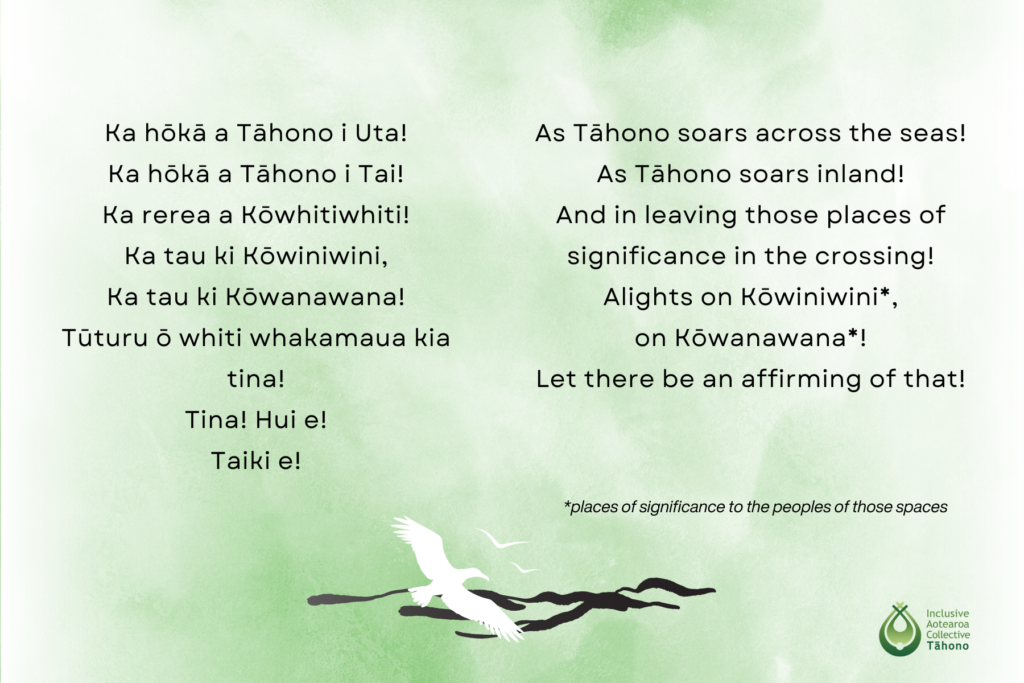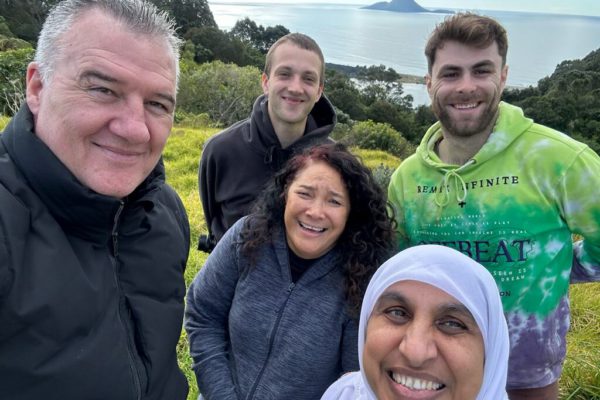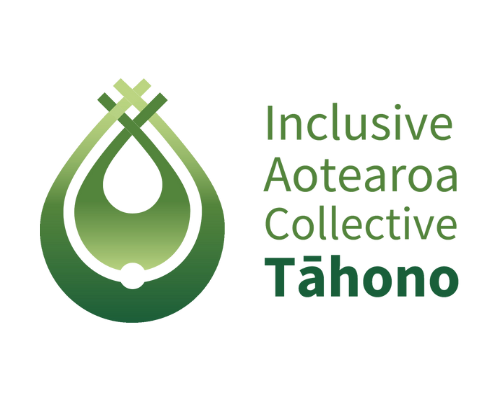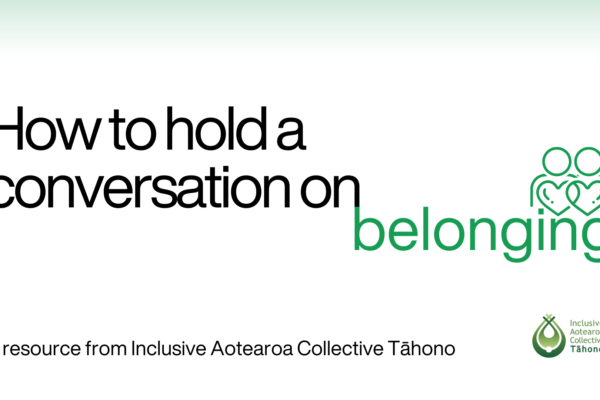The Story of Inclusive Aotearoa Collective Tāhono: Our Journey with Te Tiriti o Waitangi
From the beginning
In the formation of Inclusive Aotearoa Collective Tāhono in 2019, it was crucial that the processes and actions of our work upheld the mana of tangata whenua and Te Tiriti o Waitangi.
During the exciting–yet intense–early stages of developing our vision, we were clear that achieving a more inclusive Aotearoa could not happen without recognising tino rangatiratanga, relationships with tangata whenua, and incorporating a te ao Māori approach to our work. As staff joined Anjum in the project in 2019, the formative new tīma started to build connections nationwide in order to fulfil this commitment to Te Tiriti.
In that first year, we reached out to our networks and contacts to seek assistance. A notable connection during this time was in November, when we met with Professors Tom Roa and Sandy Morrison, discussing the nature of our project and what we wanted to do. They agreed to advise our work, and it was in this first meeting that Dr Tom Roa gifted us the name Tāhono. We are grateful to Tom and Sandy for their guidance, and we use the name of Tāhono proudly to this day.
2020 marked the beginning of our Belonging Conversations – a broad run of community engagement across Aotearoa, during which we tried to strengthen our connections with mana whenua across the motu. Some of these events include a Belonging hui at Te Awahina Marae in Motueka, a meeting with the Māori Womens Welfare League in the Waikato, and various meetings with people generous enough to give us advice, such as Te Raukura O’Connell Rapira, Tina Ngata, Emma Wehipeihana, Aroha Yates-Smith and others.
Expanding the rōpū
During the Belonging Research, Kym Hamilton suggested to Anjum that she talk to Te Huia Bill Hamilton after they met for an interview for Aotearoa 2020 Vision. Anjum organised a meeting with him, which proved to be a giant step in our Te Tiriti journey.
Te Huia was highly supportive and helpful in guiding us through why we wanted to be a Te Tiriti-based project and what this might look like. From here, we worked together to develop a memorandum of understanding for the National Iwi Chairs Forum. In this MoU, we stated that we would use our funding to pay for one FTE position from Pou Tikanga to join the staff of IACT, as at this point, the organisation was using the research from the Belonging Conversations to develop constellations in 2021.
Three people were nominated from Pou Tikanga to hold that space: Atarau Hamilton-Fuller, Adrian Te Patu, and Keriana Tawhiwhirangi. The advisors from Pou Tikanga initially set up a caucus led by Keriana, who would take the ideas discussed back to the broader IACT team. However, they soon agreed that the whole team should work together to build its commitment to being Te Tiriti-aligned. In August 2021, it was decided that Keriana would become the co-lead of Inclusive Aotearoa Collective Tāhono alongside Anjum, developing a co-governance leadership model.
The team established a Matike Mai reading club, where our kaimahi engaged with and discussed the concepts and recommendations outlined in that report. In reflection, a crucial part of our project’s journey with Te Tiriti o Waitangi was creating the space to discuss, explore, and share the different experiences and stages that individual staff were at in their personal journeys. As a team, our learning was consolidated at Papatuanuku Marae, where we participated in a workshop facilitated by Treaty People.
In February 2021, Dr Tom Roa gifted Tāhono with a whakataukī inspired by the toroa (albatross), a symbol of peace. The whakataukī tracks the toroa as it soars across the seas, to its nesting sites inland, and how it sews offshore and onshore together in its flight.

Aligning our mahi
Keriana and one of our project facilitators, Graeme Storer, developed Te Toto Kei Roto, a network that brought together activists and advocates from diverse backgrounds and perspectives who agree that TeTiriti o Waitangi, embodies values that provide a political foundation for the future of Aotearoa New Zealand. This group met over the course of 2022 and rekindled the Whakatāne Association for Racial Understanding group that was originally conceived in 1985.
Te Huia had a conversation model based on the concept of tūrangawaewae, which was used to start conversations about personal relationships with Te Tiriti o Waitangi. We used this model across a variety of events, both online and offline, which resulted in the Tūrangawaewae Stories Report from 2022. Some of the groups that we workshopped this model with include Tauiwi Tautoko and the Ministry of Social Development.
Seasons change, as does the structure and kaimahi of IACT. In 2022, Gareth Jones (Te Arawa, Tainui & Taranaki) joined the project in a leadership position, maintaining a tangata whenua co-lead. The co-lead structure is not a simple meeting between two worldviews but a dynamic exchange of ideas, learning, and leadership methods, which was sometimes challenging and incredibly rewarding.
In 2023, we developed a Te Tiriti o Waitangi education programme and worked alongside various entities, including YWCA, English Language Partners, the University of Auckland’s Centre for Asian Health Research and Evaluation, and ChangeMakers Resettlement Forum. In these workshops, we focus on the historical context and impacts of colonisation on tangata whenua, and support communities and organisations in finding their place in Te Tiriti. These workshops, grounded in belonging and inclusion, have reinforced lessons from our own journey and offer opportunities for our wider staff to participate in further learning and engagement.
Also, last year, we continued building relationships with mana whenua through Bridging Cultures. This programme focused on bringing diverse local communities to the marae to build intercultural belonging to each other and the rohe through local hāpū storytelling, whānaungatanga workshops, and Te Tiriti o Waitangi education. We ran this initiative in partnership with Marae from Papakura to Invercargill, with more planned for 2024.
The journey is not over
Moving forward in 2024, we continue to recognise the importance of Toitū te Tiriti, now more so considering the processes that conspire to restrict tino rangatiratanga and the rights of the treaty.
In the coming year, we plan to:
- Continue and expand our Te Tiriti education programme to a wider audience;
- Continue strengthening our relationships with mana whenua;
- Continue and develop our Bridging Cultures programme to different rohe across Aotearoa;
- Revamp a public programme focused on a Matike Mai bookclub;
- Continue and strengthen the voices of allies that are activating positive understandings of Te Tiriti o Waitangi;
- Continue to listen, ask questions of others and ourselves, and reflect on what it means to be a valuable and authentic Te Tiriti o Waitangi ally organisation.
We view this last point as essential, as we continue to support in, engage in, and listen to national conversations on toitū te Tiriti and constitutional reformation.
This year, we were fortunate enough to participate in the Designing our Constitution 2024 conference held by Te Kahui Tika Tangata (Human Rights Commission). Kōrero from those workshops revealed an opportunity to form and lead a collaborative approach in informing and delivering constitutional perspectives to wider tauiwi networks while supporting tangata whenua in their actions in constitutional transformation. We also heard the whakaaro from Hui aa Motu at Tūrangawaewae Marae in January. Conversations such as these remain with us and continue to guide and shape our kaupapa.
A journey rarely takes form as a linear, straight line. More realistically, a journey will often involve traffic, getting lost, and might involve finding one’s way around a maunga. Our relationship to Te Tiriti o Waitangi is dynamic and has had its share of challenges and progression. Most important in a journey is a commitment and dedication to the desired destination, and for us is: an Aotearoa where everyone has a place to belong, which upholds Te Tiriti o Waitangi, including tino rangatiratanga and the normalisation of te reo and tikanga Māori.




